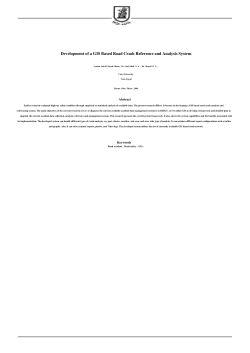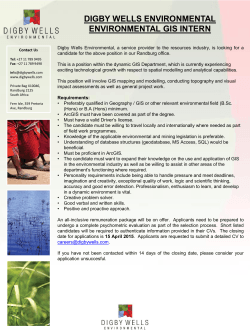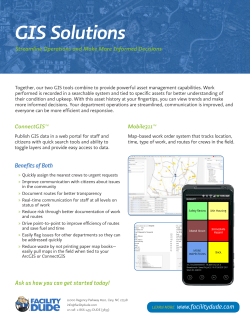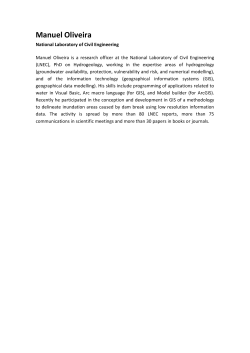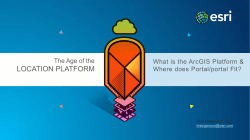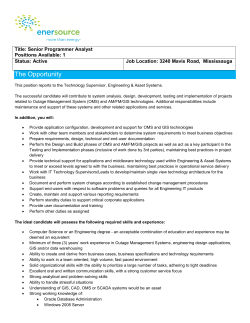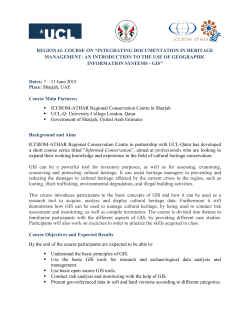
Zero to Enterprise GIS Brief
Zero to Enterprise Geographic Information Systems (GIS) A Brief Strategy Overview 2015 Prepared by: LOGIC Solutions Group The information, format and techniques contained in this Document may include trade secrets, confidential and / or proprietary information of LOGIC Solutions Group, LLC (LOGIC), the disclosure of which might provide a competitive advantage to others. As a result, this Proposal and any supporting attachments should not be disclosed, used or duplicated - in whole or in part – by anyone for any purpose without explicit permission from LOGIC. This document is subject to any applicable Non-Disclosure Agreements in force. Enterprise GIS Zero to Enterprise GIS Many businesses regard their geospatial data as the printed map on the wall in the hallway or in the landman’s office, although in reality, there are many steps between locating a new asset, well, facility, incident or other important feature and placing a map on the wall. Geographic Information Systems (“GIS”) represent the people, processes, data and systems required to accurately map a company’s assets in a timely manner with the appropriate attributes and metadata to make it useful, valuable and ultimately discoverable. High quality spatial information at the right moment can make the difference between drilling in the right location or the wrong location. Millions of dollars and liability are often at stake. GIS Maturity Life Cycle Many organizations utilize spatial data and systems and may not realize they are using a type of “GIS.” Other organizations have a mature GIS available to their entire enterprise in various capacities from robust desktop data management to lightweight field mobile devices. Through decades of experience, LOGIC has identified the various stages of GIS maturity and can assist our clients in achieving greater value from their GIS wherever they are on the maturity lifecycle and work with them to achieve stronger adoption. LOGIC has coined the phrase “Zero to Enterprise” to describe the maturity lifecycle. An advanced GIS may have many advantages for an organization. Enterprise GIS solves issues such as alleviating multiple versions of the truth, data duplication, manual data entry (and re-entry), security and backup / restore for geospatial information. A mature, enterprise GIS improves data quality and ensures that whenever someone asks the same question within a company that they get the same answer. The phases identified and discussed below are Basic, Standard, Advanced and Strategic. The stages describe where clients are often found, not necessarily the correct, linear path to achieve a healthy GIS end state today. Contributing factors such as historical momentum, business drivers, and the economy can sometimes blur the “right” path for companies to go from zero to enterprise, as it is not a one size fits all journey. Phase 1 – Basic Key Words: Basic, not standard, not repeatable, manual, chaos Within many organizations, employees use various mapping tools to achieve their job: Esri desktop tools, Google Maps, Bing Maps, CAD, geoscience tools such as Petra or Petrel or whatever is available. In this scenario, there is often no coordinated strategy or structured effort to consolidate applications, control data quality, control data flow or backup valuable company assets. The paper map is often seen as the final work product and the company’s most valuable spatial asset in this transaction. The map may be a marked-up screen capture from Google Maps or something similar scanned and emailed from one business user to another and then lost behind a file cabinet. Enterprise GIS provides the opportunity for exponential improvement in this process. ________________________________________________________________________________________ LOGIC Solutions Group Enterprise GIS – A Brief Strategy Overview © 2015 All Rights Reserved 1 This is the first phase on the GIS maturity life cycle. Essentially the company is living with a “nonenterprise” environment: emails and faxed maps, multiple versions of the truth; lack of effective data standards and governance. When the company realizes that the data and ideas that went into the map creation are the real company assets, they are poised to begin the next maturity phase. Phase 2 - Standard Key Words: Data, data master, ETL, automation, simple web map As a company acknowledges that the spatial data they are creating, purchasing and making decisions upon is a valuable corporate asset that should be maintained and centralized, they are moving into the Standard phase. Organizations in Phase 2 will be setting up a secure, backed up corporate spatial repository that can come in various configurations and architectures, which may include at least a two-tier system of Test and Production. Critical considerations during this phase include the use of industry data models, projection choice and versioning approach, as well as data set sizes and geographic extent. The company’s spatial data is now backed up via a Service Level Agreement with IT and the valuable map that fell behind the file cabinet can be easily regenerated. In addition, there can be multiple versions of the map generated easily per asset, department, time horizon or various other features of interest. Now maps can be shared across the enterprise. In the Standard stage, companies may have already rolled out a simple or complex web map viewer with an older technology such as Silverlight or Flex. These monolithic, code heavy applications are often difficult to support or migrate, but do generally advance the company’s ability to disseminate maps to the organization. Phase 3 - Advanced Key Words: ArcGIS Platform, sharing, self-service, focused Web Maps and Apps ArcGIS Online (“AGO”, “AGOL”) and Portal for ArcGIS (“Portal”) are Esri’s newest web GIS offerings that help organizations find and share information with those who need it via maps and applications. It provides a framework to easily author and share maps within your organization. Together with the numerous free applications, Esri’s Web App Builder (easy to use map application authoring tool) and numerous Widgets (Esri map plug-ins) that fit into AGO and Portal, this is often times referred to as the Esri “Platform”. In Phase 3, organizations have implemented the Esri Platform. Users can now publish their own data, create their own maps and then share that editable map with the organization or a focused group. They are creating powerful, discoverable maps and can mash up premium data services (such as subscription based weather data) along with company assets. They are using the Incident Management and Production Summary Widgets (Esri supplied accelerator applications) to access key company data sets intuitively and quickly. The company is using Esri’s Collector app (Esri supplied offline-online mobile application for native Windows, Apple or Android) on their iPad or other device to quickly display all the wells around them in a field as intuitively as if they were displaying the local Starbucks locations. ________________________________________________________________________________________ LOGIC Solutions Group Enterprise GIS – A Brief Strategy Overview © 2015 All Rights Reserved 2 In the Advanced stage, some GIS governance is established to manage change, data acquisition, data standards and security. Phase 4 - Strategic Key Words: ArcGIS Platform, governance, repeatability, value, anticipate user needs, high-grade data As GIS user adoption and application usage increases, specific business application use cases or workflows that require map integration will result. Examples might include an application for managing prospect to spud structured and unstructured well data (“well life cycle”), a dashboard to monitor data quality, a predictive analytics tool for field optimization or a well bore path avoidance solution. The map can become a vital and central component to the concepts and applications. With the Platform in place, various geospatially enabled Business Intelligence, document management and collaboration applications can be configured and developed to support land, geology, geophysics, drilling, engineering, production, pipeline, health and safety, inspection and maintenance. Map driven access to documents, interactive charts and graphs, and workflow and notifications become expected, intuitive integrations into key business applications. The GIS team is now proactively addressing user needs. They are pre-processing and high-grading data (joining with other business data, averaging, summing, symbolizing and more). When a business user accesses a map, the complexity of querying, interpreting and mashing up of data is already done and hidden behind the scenes; the answer they are looking for is already on the map in front of them. The competitor analysis map, the top ten performing and bottom ten performing wells map, the offshore platform people and assets endangered by the impending storm map are pre-rendered and ready to act on. Geospatial governance is now fully functional with GIS viewed as a specific discipline with an appropriate career path and dedicated staff members. There are GIS Analysts, Geospatial Data Managers, GIS Managers and Supervisors and Geodesists within the organization among other direct and peripheral geospatial roles. The organization is realizing the full value of the ArcGIS Platform. GIS is seen as a key company asset and tool for growth. Maps for everyone. Achieving Enterprise GIS A mature GIS supports the enterprise with improved search and discoverability, collaboration, decision making and provides a single, trusted source of the truth via an intuitive map interface. The path from zero to enterprise can be much quicker today thanks to the Esri Platform’s own maturation. Today, an “evergreen” company can implement the Esri Platform for key vendor data sets quickly and easily, leveraging the power of the Platform before they address their own internal workflow, data sets and quality issued. And by doing so, they are able to jump start a GIS revolution within the company, accelerating their path to an Advanced or even Strategic GIS. Whatever stage you are in, LOGIC can help. ________________________________________________________________________________________ LOGIC Solutions Group Enterprise GIS – A Brief Strategy Overview © 2015 All Rights Reserved 3 Figure 1: Zero to Enterprise GIS Next Steps Many organizations are just beginning the journey or are far down the road in the maturity lifecycle. In any case, assessing your organization’s maturity level might assist in identifying gaps or opportunities to further and fully utilize this valuable company asset. LOGIC Solutions Group has deep GIS and Esri roots and can help your organization assess gaps and opportunities with your enterprise GIS initiative. Our proven Enterprise GIS Assessment effort will quickly review your “As-Is” GIS and upstream environment and provide a strategic roadmap forward. In addition, our Platform Quick Start will leverage value out of the Platform today with low risk and high impact to your organization. LOGIC can assist with full scale turnkey supporting projects through onsite consulting in support of the GIS initiatives. ________________________________________________________________________________________ LOGIC Solutions Group Enterprise GIS – A Brief Strategy Overview © 2015 All Rights Reserved 4 Why LOGIC? LOGIC Solutions Group (LOGIC), a VSS company, is global provider of enterprise business solutions for the oil & gas industry. LOGIC’s highly experienced team is focused on working to create, manage and integrate information management and geospatial assets to provide insight into the oil and gas life cycle. Additional information on LOGIC Solutions Group and our service offerings can be accessed at www.LOGICsolutionsgroup.com. ________________________________________________________________________________________ LOGIC Solutions Group Enterprise GIS – A Brief Strategy Overview © 2015 All Rights Reserved 5
© Copyright 2025
